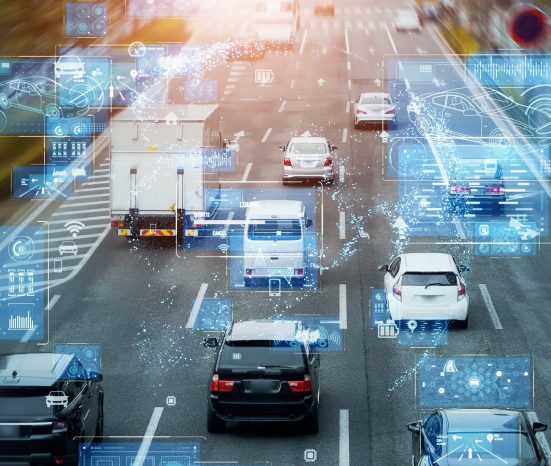Autonomous Vehicles
What are Autonomous Vehicles?
An autonomous vehicle, also known as a self-driving car, driverless car, robotaxi, or robo-car, is a vehicle capable of operating with reduced or no human input. These vehicles handle all driving activities, including perceiving the environment, monitoring critical systems, and controlling the vehicle. Here are some key points about autonomous vehicles:
Levels of Autonomy
The Society of Automotive Engineers (SAE) defines six levels of automation in vehicles:
- Level 0: No automation; the human driver performs all tasks.
- Level 1: Driver assistance systems (e.g., adaptive cruise control).
- Level 2: Partial automation; the vehicle can control both steering and acceleration/deceleration.
- Level 3: Conditional automation; the vehicle can manage most driving tasks but requires human intervention in certain situations.
- Level 4: High automation; the vehicle can operate without human intervention in specific conditions or geofenced areas.
- Level 5: Full automation; no human intervention needed under any circumstances.
History
Experiments on advanced driver assistance systems (ADAS) date back to the 1920s. The first semi-autonomous car was developed in 1977 in Japan, relying on specially marked streets and cameras. Projects like Carnegie Mellon University’s Navlab and ALV contributed to autonomous research in the 1980s.
Current State
As of early 2024, no system has achieved full autonomy (SAE Level 5). Waymo, DeepRoute.ai, and Cruise offer self-driving taxi services at various levels of autonomy in specific regions. Honda and Mercedes-Benz have introduced SAE Level 3 cars.
Impact and Challenges
Autonomous vehicles have implications for the automotive industry, urban planning, traffic, insurance, and more. Appropriate regulations are essential for integrating autonomous cars into existing environments.
Autonomous Vehicles and the Aerospace Industry
Autonomous flight is a fascinating area that combines cutting-edge technology with safety and efficiency. Here are some notable developments:
Airbus and Autonomous Flight
Airbus, a major player in the aerospace industry, has been actively exploring autonomous technologies to enhance flight operations. Their vision is to “pioneer sustainable aerospace for a safe and united world.” They adapt the level of automation based on market segments, products, and expected benefits to achieve the safest and most efficient operations.
Projects and Innovations
- AirSense: This project focuses on enhanced situational awareness and advanced analytics for better decision-making in aviation. It anticipates operations, increases fuel savings, and ensures a safer sky by providing easy-to-consume data.
- Auto’Mate: A demonstrator that evaluates technologies for autonomous air-to-air refuelling during formation flight operations. Key technologies include accurate relative navigation, in-flight communication, and cooperative control algorithms.
- ATTOL (Autonomous Taxi, Take-off, and Landing): This groundbreaking project successfully demonstrated fully autonomous taxi, take-off, approach, and landing using a commercial aircraft. It leveraged computer vision technologies and techniques, marking a world-first achievement.
- DeckFinder™: A local positioning system enabling manned and remotely piloted aerial systems (RPAS) to determine their relative position even in challenging GPS-shaded environments. It contributes to safer take-off and landing procedures where visual cues are lacking.
Technology Behind Autonomy
- Equipping aircraft with an extensive suite of sensors, including computer vision cameras, radar, and lidar.
- Constantly updating maps, GPS navigation, and powerful computers capable of processing vast amounts of real-time data.
- Sophisticated software with artificial intelligence to enable true autonomy rather than just high automation.
Evolution of Autonomous Vehicles

The evolution of autonomous vehicles has progressed from early experiments in the 1920s to sophisticated prototypes today. Initial developments focused on advanced driver assistance systems (ADAS), leading to the first semi-autonomous car in 1977. In recent decades, projects like Carnegie Mellon University’s Navlab and advancements by companies such as Waymo and Tesla have driven significant improvements in vehicle autonomy. As of early 2024, while full autonomy (SAE Level 5) has not been achieved, substantial strides have been made in deploying various levels of autonomous technology in real-world scenarios.
Aerospace & Autonomous Vehicles in Future
In the future, the relationship between aerospace and autonomous vehicles is expected to become increasingly intertwined, driving significant advancements in both sectors. Autonomous technologies will enhance aerospace operations through improved in-flight connectivity, predictive maintenance, and efficient air traffic management. Similarly, innovations in aerospace, such as autonomous flight systems and AI-driven navigation, will influence the development of ground-based autonomous vehicles. This symbiotic relationship promises to elevate safety, efficiency, and operational capabilities across both industries, paving the way for a more connected and autonomous future.

Frequently Asked Questions
Common questions and answers pertaining to autonomous vehicles, especially in regards to aviation.
How do autonomous vehicles and aircraft differ in terms of autonomy?
Autonomous vehicles primarily operate on roads and rely on sensors, cameras, and AI to navigate and avoid obstacles. Autonomous aircraft, on the other hand, utilize advanced systems like autopilot, GPS, radar, and lidar to manage in-flight operations, air traffic control communications, and more complex three-dimensional navigation.
What are the main benefits of integrating autonomous technology in aviation?
The integration of autonomous technology in aviation enhances safety by reducing human error, improves operational efficiency through precise navigation and optimized flight paths, and enables predictive maintenance, which reduces downtime and maintenance costs.
What challenges do autonomous vehicles and aircraft face?
Both autonomous vehicles and aircraft face challenges such as ensuring the reliability and safety of autonomous systems, managing the vast amounts of data generated, addressing cybersecurity threats, and navigating regulatory and legal frameworks for autonomous operations.
How will autonomous technology impact the future of aviation?
Autonomous technology will revolutionize aviation by enabling fully autonomous flights, enhancing in-flight assistance and co-piloting, optimizing air traffic management, and improving overall safety and efficiency. This technology will lead to more reliable and cost-effective operations, paving the way for innovations like urban air mobility and drone-based delivery systems.
Video Explanation
The video below will provide more information as to how this technology works
Example Industry User

Hybrid Air Vehicles may use autonomous vehicle technology in the future to enhance the safety and efficiency of their airships. Autonomous systems could enable precise navigation and real-time decision-making, allowing the airships to operate in challenging weather conditions and remote areas without human intervention. This technology could also optimize flight paths and improve fuel efficiency, reducing operational costs and environmental impact. Additionally, integrating autonomous capabilities would make their airships more versatile for various applications, such as cargo transport, surveillance, and disaster response.
Further Resources
Below are some external links to further information on this technology.




